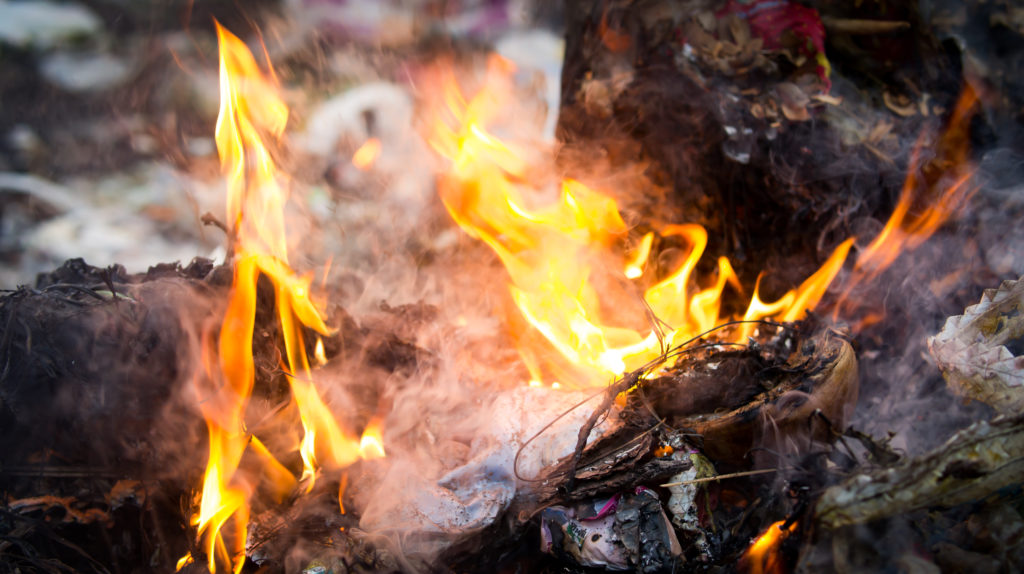
Burning waste of any kind is hazardous to our health and the environment and undermines real solutions to our trash crisis. Photo: Shutterstock
Rhode Island – and all of New England – has a trash problem. There’s simply too much of it, and the ways we dispose of it hurt our health and environment. What’s more, plastic pollution is damaging our communities and putting wildlife on land and in the sea at risk.
Rhode Island had the chance to ban single-use plastics this past legislative session. Yet, the General Assembly failed to take bold action against single-use plastic straws and bags. Moreover, legislators seriously considered two bills (H5448 and S408) that would have allowed the state to burn waste, including plastic, through dangerous processes known as gasification and pyrolysis.
By law, Rhode Island cannot use incineration as a way to manage its waste. However, the proposed bills aimed to weaken the law and exempt the burning of plastics from this restriction.
Thanks to efforts by CLF and several other environmental organizations, both bills failed to become law. However, the Senate did pass a resolution authorizing a commission to “study the merits and feasibility of developing a pyrolysis or gasification facility in the state.”
The reality is, these facilities hold no merit and are not financially feasible. Any burning of waste endangers our health, our climate, and our environment. CLF will track the Rhode Island commission’s progress and will oppose any proposal to allow such a facility here or in any New England state.
Gasification and Pyrolysis: Incineration by Different Names
Gasification and pyrolysis are both forms of waste incineration. Where conventional incineration burns trash from cities and towns in oxygen-rich environments, gasification and pyrolysis have limited oxygen, heating waste to temperatures as high as 2,800° Fahrenheit. With limited oxygen and high heat, these facilities generate synthetic gases and oils, along with ash, char, and air pollution. They are dangerous to our health and to our environment.
No Matter What You Call It, Burning Trash Creates Harmful Pollution
Contrary to claims made by gasification and pyrolysis supporters, these are not “clean” technologies. The air emissions from these facilities are similar to conventional trash incinerators. They spew a number of cancer-causing compounds described as the most toxic chemicals known to humankind. Moreover, the ash “byproduct” of these processes is contaminated with dioxins, mercury, and other heavy metals, all of which leaches into our groundwater, rivers, and lakes.
But the pollution doesn’t end there. The synthetic fuel produced at gasification and pyrolysis facilities is later burned to generate energy. Just like with any other oil or gas, this burning expels climate-damaging emissions, plus heavy metals and dioxins.
Burning Trash is Expensive, Inefficient, and Unreliable
Even if burning waste didn’t create air and carbon pollution, gasification and pyrolysis are unsound investments that create expensive fuel and little to no financial return. Studies have shown that these facilities use as much as 87 times more energy than they produce. Such massive energy consumption, along with high building and operating costs, make it difficult for gasification plants to be financially viable. This also makes them a more expensive option than composting, recycling, and even landfilling.
Originally, gasification and pyrolysis technologies were designed to burn fuel sources such as wood chips or coal. Modern trash, however, is comprised mostly of food waste, yard trimmings, plastics, glass, metal, paper, cardboard, electronics, and hazardous waste. Because our trash varies in composition and moisture content, it’s difficult for facilities to maintain stable temperatures in thermal reaction vessels. This can cause operating conditions to become problematic and facilities to potentially break down, decreasing efficiency and increasing operating costs.
Because of these environmental and financial obstacles, many attempts at large-scale waste gasification have failed:
- A plant in Dargavel, Scotland, opened in 2009 and closed in 2012 after the Scottish Environmental Protection Agency revoked its permit due to the facility’s failure to comply with pollution limits or efficiently recover energy.
- A gasifier in Karlsruhe, Germany, closed in 2002 after operating at a net energy loss for several years.
- In 2004, a gasifier in Wollongong, Australia, closed after three years of consistent operational problems and emissions violations.
These are not anomalies – environmental and financial failure are the norm for gasification and pyrolysis facilities.
Burning Trash Undermines Composting and Recycling Programs
Gasification and pyrolysis facilities rely on burning organic waste that could otherwise be composted, as well as paper, glass, and plastic that could be recycled. Compared to incineration, recycling and composting cost towns and cities less money and generate three to four times as many local jobs. It makes little sense to use inefficient, expensive, and polluting processes to turn these materials into toxic fuel when we can save money and protect our communities and climate by adopting zero waste alternatives.
CLF will be monitoring the upcoming Rhode Island study commission to make sure our government officials understand the many problems with burning our trash. And we will be making sure that the unreasonable notion of burning our way out of our trash problem doesn’t catch fire in other New England states.



